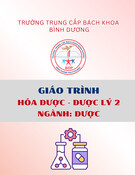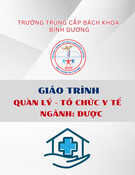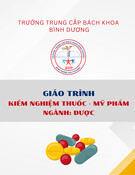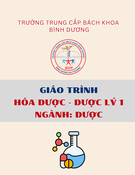
Learning Styles of Pharmacists: Impact on Career Decisions,
Practice Patterns and Teaching Method Preferences
ZUBIN AUSTIN*
Faculty of Pharmacy, University of Toronto, 19 Russell Street, Toronto, Ontario, Canada M5S 1A1
(Received 4 November 2003; In final form 12 December 2003)
This study examined possible associations between
learning styles of pharmacists (as identified through
Kolb’s Learning Styles Inventory (LSI) and the Pharma-
cists’ Inventory of Learning Styles (PILS)) and career
decisions, practice patterns and teaching method pre-
ferences. A total of 166 pharmacists were involved in this
study and completed either the LSI or the PILS, and a
supplemental questionnaire. Of them, 33.7% of the
respondents were identified as Assimilators, 32.5% as
Convergers, 21.1% as Divergers and 12.1% as Accom-
modators. Results suggest that there is a statistically
significant correlation between identified learning style
and teaching method preferences as well as years since
graduation. While there was no statistically significant
correlation between learning styles and gender, career
decisions or practice patterns, there does appear to be a
trend that warrants further investigation. Implications
for delivery of continuing education are discussed, since
learning preferences for each group varied considerably.
Keywords: Learning styles; Learning preferences; Pharmacy
education; Pharmacy practice
BACKGROUND
Learning styles have been defined as “...the different
ways in which children and adults think and learn”
(Litzinger and Osif, 1993). The notion that individ-
uals differ in the way they approach learning
situations, problems or challenges is self-evident.
Numerous terms have been devised to describe the
plethora of strategies and approaches used by
individuals: learning by seeing, visual learning,
auditory learning and learning by doing are
examples of terms that attempt to encapsulate
learning styles (Austin, 2002). While each term
suggests a certain preference or reliance on a specific
strategy, few would suggest that each term is all
encompassing. For example, those who may prefer
learning by doing, are also capable of learning by
reading, and will balance different approaches
depending upon a variety of environmental and
personal contingencies.
Nonetheless, the notion of individual learning
styles or preferences has become widely accepted in
education (Norman and Schmidt, 1992), psychology
and human resources planning (Quenk, 2000).
Numerous theories have been put forth to account
for the existence of different, individual specific
learning styles, ranging from social structures to
personality traits to power dynamics. While the
specific reasons for different learning preferences
may be controversial, most individuals agree that, as
individuals, we learn and approach learning situ-
ations in highly variable ways (Blagg, 1985; Felder,
1993; Keane, 1993).
In the literature, significant attention has been
paid to the notion of learning styles as they apply
to educational settings (Kolb, 1981; Felder and
Silverman, 1998; Janing, 2001). Within the context
of professional education, Felder and Silverman
(1998) have written considerably on technical
disciplines such as engineering. Their work suggests
that students take in and process information using
a variety of strategies. These strategies are best
understood as continua, with anchors that act as
exemplars rather than exact descriptions of any
individual’s learning style. They cite specific
continua such as seeing and hearing, reflecting
and acting, reasoning logically and intuitively, and
analyzing and visualizing as broad descriptions
ISSN 1560-2214 print/ISSN 1477-2701 online q2004 Taylor & Francis Ltd
DOI: 10.1080/1560221042000193310
*E-mail: zubin.austin@utoronto.ca
Pharmacy Education, March 2004 Vol. 4 (1), pp. 13–22

of individual preferences. In their theory, each
individual demonstrates a certain learning prefer-
ence as a point along the continuum represented by
each pair of terms. Such learning preferences will
evolve with time within an educational setting and
in response to curriculum and other interventions;
however, with maturing and development,
individuals will demonstrate more fixed preferences
for specific modes of information intake and
processing.
Gardner (1999) has approached the issue of
learning styles from a more behavioral perspective,
identifying the choices individuals (both children
and adults) make whilst participating in learning
situations and interpersonal relationships. His
“Multiple Intelligences” approach suggests there
are seven primary ways in which environment and
individual learning may interact.
.Verbally (through words)
.Logically (through propositions, questions, or
mathematics)
.Visual-Spatially (through images, pictures,
abstract representations)
.Aurally (through music and rhythm)
.Kinesthetically (through movement or physical
activity)
.Interpersonally (through social interaction)
.Intrapersonally (through independence or self-
interaction)
The Multiple Intelligences approach suggests
that individuals, over time, demonstrate a reliance
on one or more of the modes of inquiry described
above. For example, a kinesthetic learner prefers
learning situations that rely upon movement and
activity (such as laboratory based education),
while an interpersonal learner prefers learning
situations that tend more towards social inter-
action (such as problem-based learning tutorials).
Despite these personal preferences, individuals
must, can, and do learn to learn in any and all of
these modes.
Kolb’s (1981; 1984; 1999) theory of learning styles
posits two major axes (or dimensions) upon which
learning preferences are constructed. One axis is
built upon anchors related to performance (“Doing”
vs. “Reflecting”) and relates to the ways in which
individuals prefer to receive or take in information.
The second axis is built upon anchors related to ways
in which individuals prefer to process information
once it has been received: “Experiencing” vs.
“Thinking”). The intersection of these two axes
produces four quadrants, each corresponding to a
distinct learning preference.
.Concrete Experience:beingdirectly,actively,
involved in a learning situation.
.Reflective Observation:watchingothers,or
developing observations based on one’s own
experience, in a learning situation.
.Abstract Conceptualization: creating theories to
explain and understand observations.
.Active Experimentation: using (or applying)
theories to solve problems and make decisions.
According to Kolb’s theory, individuals tend
to express preferences along these domains.
For example, individuals who have preferences for
both concrete experience and reflective observation
will demonstrate learning attributes that differ from
those who prefer active experimentation and abstract
conceptualization. Kolb’s theory distills these
notions into four major “learning style types”.
.Diverging: Combining elements of concrete
experience and reflective observation, Divergers
tend to view situations from multiple perspec-
tives. Their bias is towards observation, rather
than action. They tend to enjoy brainstorming and
idea generation, and value harmony, listening
with an open mind and giving and receiving
personal feedback.
.Assimilating: Combining elements of reflective
observation and abstract conceptualization,
Assimilators tend to focus less on individual
needs and more on ideas, concepts and logical
arguments. Assimilators tend to enjoy analy-
tical work and having time to think things
through rather than be put on the spot.
.Converging: Combining elements of abstract
conceptualization and active experimentation,
Convergers demonstrate a preference for practical
uses for ideas. They work well in time-pressured
situations where problems must be solved and
decisions must be made. Convergers tend to
prefer to lead, rather than follow, and may prefer
dealing with technical tasks and problems rather
than social or interpersonal issues.
.Accommodating: Combining the elements of
active experimentation and concrete experience,
Accommodators learn best from hands on
experience. They make decisions quickly and
decisively, value time efficiency and completing
tasks expediently.
The four learning styles identified by Kolb are not
intended to be definitive nor diagnostic. Kolb makes
the point that individuals, in their daily life, flex their
way through all learning styles depending upon
circumstances and environment. Learning styles are
not “pigeon holes” into which individuals fall, nor
are they stereotypes to which individuals rigidly
conform. Instead, individuals with a specific learn-
ing style generally share certain commonalities with
respect to approaches to learning, and this may be
Z. AUSTIN14

a useful way of initiating discussion and promoting
self-reflection upon teaching and learning.
Within the learning styles literature, various trends
have been noted. For example, human resources
professionals and career counselors may utilize
learning styles theory as a way of assisting with
vocational counseling (Quenk, 2000). There is some
literature, and anecdotal information, suggesting
that individuals with certain learning preferences
may express specific career patterns aligned to the
characteristics of that learning preference (Kolb,
1999; Quenk, 2000). For example, general character-
istics of Divergers include dealing creatively with
ambiguity, being sensitive to others’ needs and
feelings, and valuing creativity and self-expression.
It has been noted that there may be a preponderance
of Divergers in fields such as social work, psycho-
logy, nursing, literature, design and theatre/film.
Conversely, general characteristics of Assimilators
include strong organizational skills, and the ability to
analyze quantitative data. It has been suggested that
there may be a preponderance of Assimilators in
fields such as scientific research, biology, accounting
and information sciences. General characteristics of
Convergers include willingness and ability to make
rapid decisions in ambiguous situations, and leader-
ship. Anecdotal information suggests that certain
medical subspecialties (such as emergency medicine
and surgery) tend to attract Convergers. Finally,
Accommodators often demonstrate skills in time and
resource management, and dealing directly with
people and situations. Anecdotal information
suggests that, within the health professions, there
may be a preponderance of Accommodators among
technologists (such as radiation or respiratory
technicians).
Conspicuous by its absence, there is little mention
of pharmacists within the vocational learning styles
literature. As an occupational group, pharmacists
have numerous career options, ranging from
careers in community or hospital pharmacy, or in
government, academia, consulting, research or
pharmaceutical industry. Expectations and rewards
within each career stream vary considerably, and it is
intriguing to speculate upon the potential connection
between an individual’s learning styles and his/her
preference for a certain career track within pharmacy
practice. Conversely, it may be possible to use
learning styles to identify potential misalignments
between individuals and their career choices. For
example, an individual with strongly Divergent
tendencies would not be expected to thrive within a
highly structured, technical environment, while an
individual with strongly Assimilative tendencies
may have difficulty working in an environment that
required on the spot problem solving and decision
making. While such individuals may be expected
to learn to function competently within such
environments, learning styles proponents would
argue a fundamental misfit between individual
preferences and working environment would more
likely breed discontent and disengagement.
Within pharmacy education, there have been
reports outlining use of learning styles to guide
curriculum and planning (Adamcik et al., 1996).
Pungente et al. (2002) utilized Kolb’s Learning Styles
Inventory (LSI) to identify first year students’
preferences. Their study reported a relatively even
distribution of preferences amongst survey respon-
ders ðn¼120Þ;with approximately 36% of first year
students being categorized as Accommodators, 20%
as Assimilators, 22% as Convergers and 22% as
Divergers. The authors used these results to assess
preferences towards different activities associated
with problem-based learning, and noted that
assimilators and accommodators demonstrated
somewhat higher preferences for PBL type activities
(such as independent learning, expression of
understanding through group discussions, etc.)
than did their peers who were categorized as
Divergers or Convergers. The authors concluded
that learning preferences may influence retention
and application of knowledge, and that this may in
turn be correlated to academic success as measured
by grades.
While studies such as that of Pungente et al. have
been undertaken in undergraduate educational
settings, little formal research has been undertaken
in the context of occupational choices and continuing
professional development (CPD). As practitioners,
pharmacists are required to maintain currency in
their field, and have numerous options for continu-
ing education. Popular options include lectures by
experts, personal reading and review of journals or
texts, or small group discussion circles such as
journal clubs. Such continuing education program-
ming has become standard in most areas, yet the
alignment between these teaching methodologies
and pharmacists’ learning styles has not been
adequately evaluated. Lack of alignment may (as in
the case of career decisions) breed disengagement
from continuing education with a concomitant
effect on competency. Consequently, there is
interest in understanding learning styles, learning
preferences and career development within the
profession of pharmacy within the context of
continuous professional development and career
choices.
OBJECTIVE
The purpose of this study was to determine the
relationship between pharmacists’ learning styles,
their occupational choices and continuous pro-
fessional development preferences.
LEARNING STYLES OF PHARMACISTS 15

METHODS
Participants, in this study, were two cohorts of
Canadian pharmacists attending training workshops
related to learning styles of undergraduate phar-
macy students. Cohort 1 ðn¼115Þwere predomi-
nantly involved in community or hospital pharmacy
practice. Cohort 2 ðn¼61Þwere a mixed group
representing hospital and community pharmacists,
pharmacists working in the pharmaceutical industry
and managers/administrators. All participants were
individualswhohadselfselectedtoattenda
workshop on learning styles of students, generally
because they were involved in undergraduate
or post-graduate clinical education of students, or
because of personal interest in the topic.
As part of the workshop, each participant had the
opportunity to complete a LSI. Cohort 1 completed a
modified version of the Pharmacists’ Inventory of
Learning Styles (PILS) (Austin, 2003), a learning
inventory tool based on Kolb’s LSI (see Appendix 1).
The PILS has been developed and validated in the
context of pharmacy practice, and produces results
aligned with those from Kolb’s LSI. Cohort 2
completed Kolb’s LSI tool. In addition to the
completion of the learning inventory tool, partici-
pantswereaskedtoreportonthefollowing
questions.
.Years in practice (,10, 10–14, 15–19, 20–25, .25).
.Predominant site of practice (community phar-
macy, teaching hospital, community hospital,
pharmaceutical industry or others (including
academia, licensing/regulatory affairs, consult-
ing, etc.)).
.Predominant role in practice (patient care/clinical
pharmacy services, medical information/
research, management/administration, dispen-
sing/supervision of dispensing or others (includ-
ing teaching)).
.Most preferred and least preferred form of
teaching/learning (lectures by experts, small
group discussion, reading (textbooks/journals),
patient simulations/role plays, laboratory based
activities, one to one teaching).
In addition, participants were asked to specify
their gender (male or female). To ensure face validity
of results, participants were also asked to respond to
the question “I believe my identified learning style
was an accurate reflection of my true learning
preferences” on a 4-point Likert scale.
RESULTS
A total of 176 pharmacists participated in the
workshops; all completed the LSI exercise
(either the PILS or the LSI, see appendix 1). One
hundred and seventy five participants completed
and submitted the post-workshop questionnaire.
Of these, 166 (94.9%) “strongly agreed” or
“agreed” with the statement regarding accuracy
of identified learning style. The remaining 9
“disagreed” or “strongly disagreed”; given the
discrepancy between self-identification as a learner
and results of learning styles testing, these
participants’ results were not included in any
subsequent data analysis.
Of the 166 responses that were analyzed, 113
(68.1%) were from female pharmacists and 53
(31.9%) were from male pharmacists. Of
these respondents, 56 (33.8%) were categorized
as Assimilators, 54 (32.7%) were categorized as
Convergers, 35 (21.2%) were categorized as
Divergers and the remaining 21 (12.1%) were
Accommodators (all percentage figures subject to
rounding).
Participants in this study represented all ages: 30
(18.1%) had been in practice less than 10 years, 32
(19.3%) had practiced for 10–14 years, 55 (33.1%) had
practiced for 15–19 years, 41 (24.7%) for 20–25 years
and the remaining 8 (4.8%) had practiced for 25 or
more years.
Most participants (70 or 42.2%) reported commu-
nity pharmacy as their primary site of practice,
followed by 31 (18.7%) in hospital pharmacy (tertiary
care or teaching), 24 (14.4%) in the pharmaceutical
industry, 19 (11.4%) from community hospital
pharmacy and the remaining 12 (7.2%) from other
areas (such as teaching, licensing and regulatory
affairs, etc.).
Most participants (55 or 33.1%) cited patient care
or patient counseling as their primary role in
practice. Forty-five (27.1%) cited dispensing or
supervision of dispensing as their primary role,
and 36 (21.7%) selected administration or manage-
ment activities as their primary function. Seven
(4.2%) cited medical information or research as their
primary role in practice with the remaining 23
(13.9%) selecting “Other” as their primary role
(including consulting, teaching, not currently practi-
cing, etc.).
Amongst all participants, teaching modality pre-
ferences varied considerably. One to one coaching or
teaching (as, for example, in a clinical rotation) was
the most favored method (42 or 25.3%), followed by
small group discussions (32 or 19.3%), reading
journals or textbooks (31 or 18.7%), lectures by
experts (27 or 16.3%), laboratory based activities
(19 or 11.4%) and role playing/clinical simulations
(15 or 9.0%).
Least preferred teaching modalities showed
similar variability. Reading journals or textbooks
was the most frequently cited unappealing method
(57 or 34.3%), followed by role playing/clinical
Z. AUSTIN16

TABLE II Predominant (current) site of practice as a pharmacist
Assimilator Accommodator Converger Diverger Total
Community pharmacy 32 7 19 12 70
Teaching hospital 10 5 10 6 31
Community hospital 9 5 10 5 29
Pharmaceutical industry 5 4 11 4 24
Others 0 0 4 8 12
Total 56 21 54 35 166
TABLE III Predominant (current) role in practice as a pharmacist
Assimilator Accommodator Converger Diverger Total
Dispensing/supervision 26 8 10 1 45
Patient care/counseling 19 4 16 16 55
Management Administration 6 5 18 7 36
Medical information/research 3 0 3 1 7
Others 2 4 7 10 23
Total 56 21 54 35 166
TABLE I Years in practice as a pharmacist
Assimilator Accommodator Converger Diverger Total
0–9 years 11 4 10 5 30
10–14 years 10 2 11 9 32
15–19 years 12 11 22 10 55
20–24 years 18 4 11 8 41
.25 years 5 0 0 3 8
Total 56 21 54 35 166
TABLE IV Most preferred teaching modality
Assimilator Accommodator Converger Diverger Total
Expert lecturers 25 0 2 0 27
Laboratory exercises 0 11 8 0 19
One to one teaching 3 6 20 13 42
Reading texts or journals 28 1 0 2 31
Role playing 0 1 7 7 15
Small group discussions 0 2 17 13 32
Total 56 21 54 35 166
TABLE V Least preferred teaching modality
Assimilator Accommodator Converger Diverger Total
Expert lecturers 0 6 22 10 38
Laboratory exercises 13 0 3 3 19
One to one teaching 0 0 0 0 0
Reading texts or journals 1 10 28 18 57
Role playing 32 1 1 4 38
Small group discussions 10 4 0 0 14
Total 56 21 54 35 166
LEARNING STYLES OF PHARMACISTS 17








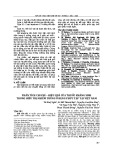

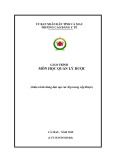
![Bài giảng Dược động học [chuẩn nhất]](https://cdn.tailieu.vn/images/document/thumbnail/2025/20251122/s236884@nctu.edu.vn/135x160/93751763955471.jpg)








